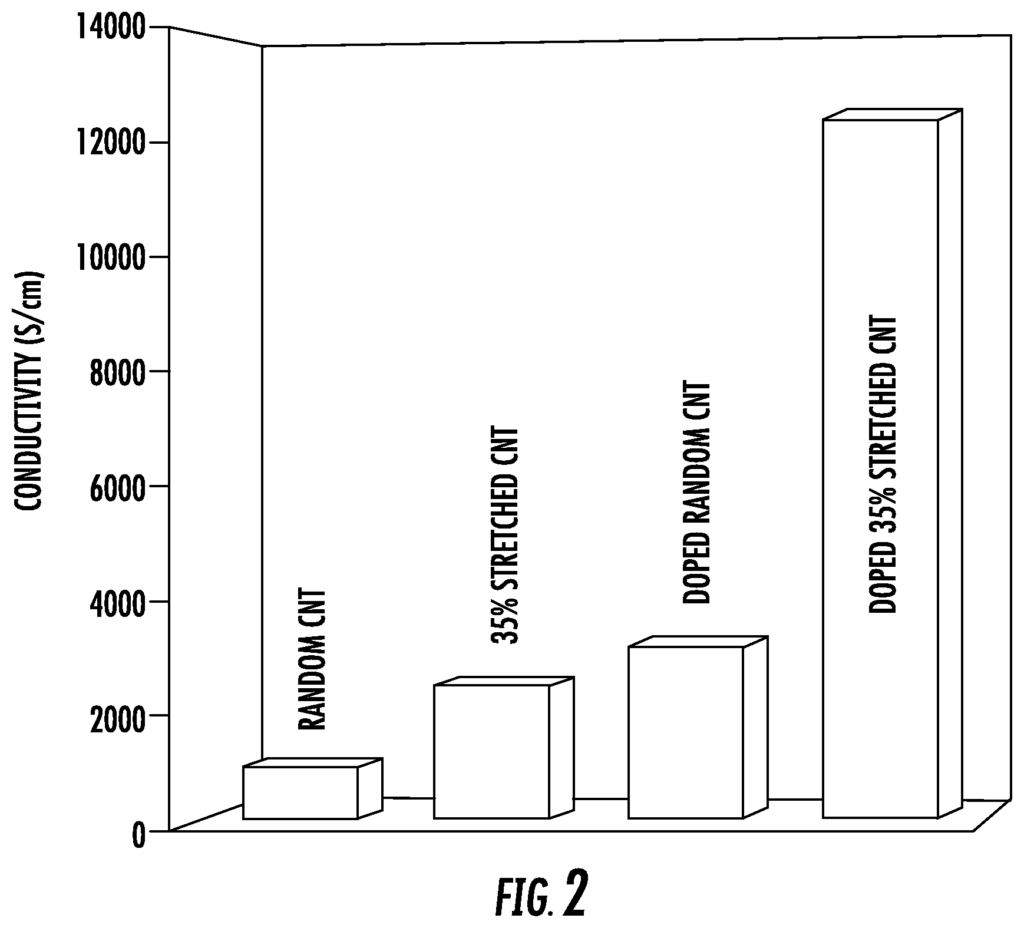Method of Large Scale Fabrication of Continuous CNT Cable/ Sheet with High Conductivity and Stability
Introduction
This invention offers a novel technique to fabricate large-scale, lightweight electrically conductive cable using carbon nanotubes (CNTs). CNTs have good intrinsic electrical conductivity. However, entangled structures of CNTs in the form of yam or sheet has lower conductivity due to intertube contact resistance and gaps in between. Lightweight and high electrically conductive CNT materials can be used for cables for such applications as signal or power transmission, electromagnetic interference (EMI) shielding in electronic devices and lightning protection in aircraft etc.
An integrated approach of three major steps was used to improve the CNT sheet conductivity:
1) Mechanical stretching of entangled CNT sheets provides CNT alignment. Random and pristine CNT sheets in rolls were continuously stretched producing narrow and densely packed CNT networks, which reduced intertube contact resistance. With increased alignment, conductivity improved two or three times higher compared to the pristine, randomly aligned CNT sheets. This process can be performed continuously and scale-up production is possible.
2) A doping approach increases the carrier concentration of CNTs. For this purpose, vapor phase iodine doping was adopted, which can be expanded to other oxidizing liquids (acids such as HNO3, HCI or SOCh). Upon this chemical doping process, conductivity improved 3-4 times and a final room temperature conductivity of 10,000 Siem (up to 13,000 Siem). The doping process is a typical diffusion process and conductivity saturated after several hours, and its speed is depended on the packing of CNTs and mobility of the dopant and followed by time.
3) An approach to coating dramatically increased the cable stability. After doping process, the dopants are diffused out and kept inside the CNT yams/sheets to maintain the conductivity. For this purpose, doped CNT sheets were dipped in air stable conducting polymer, poly(3,4-ethylenedioxythiophene)poly(styrenesulfonate)(PEDOT:PSS). The thin polymer coating on the surface provides synergetic effects for the conductivity and a protection layer. Different polymer layers, such as polyvinyl ch loride, polyethylene and rubber can also be used as protection layers as for conventional cables.

- Abstract
- Claims
Provided herein are composite materials and methods of making composite materials including carbon nanoscale fiber networks . The composite materials may include a stretched and doped carbon nanoscale fiber network and a capping layer . The methods of making the composite mate rials may include stretching a carbon nanoscale fiber net work , contacting the nanoscale fiber network with a dopant , and disposing a capping layer on a surface of the carbon nanoscale fiber network.
We claim:
1. A method of making a composite material, the method comprising:
14. A method of making a composite material, the method comprising:
Share
Title
CARBON NANOSCALE FIBER - BASED MATERIALS AND METHODS
Inventor(s)
Zhiyong Liang, Jin Gyu Park, Songlin Zhang, Ayou Hao
Assignee(s)
Florida State University Research Foundation , Inc.
Patent #
10586629
Patent Date
March 10, 2020
